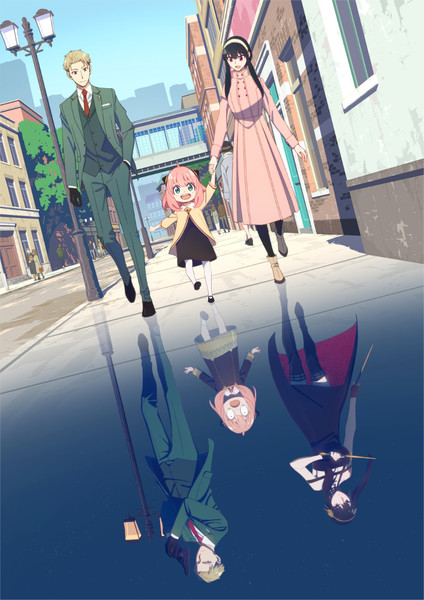How the SPY×FAMILY Creative Team Brought the Manga to Life
by Neysha Campbell,Few series manage to capture the imagination and thrill quite like SPY×FAMILY. The exhilarating espionage tale interwoven with family dynamics has captivated audiences worldwide with its unique blend of action, comedy, and heartwarming moments. Behind this remarkable anime adaptation lies a talented production team that brings the characters and their world to life, including animation producer Kazuki Yamanaka and Kyoji Asano, the character designer and chief animation director.

Yamanaka's expertise shines through his ability to create immersive and captivating animated series, including his contributions to Attack on Titan Season 1-3 and Kabaneri of the Iron Fortress. In 2022, Yamanaka took on the role of animation producer for Bubble the Movie, a film that mesmerized audiences with its stunning visuals.
Renowned for his exceptional talent and artistic vision, Kyoji Asano has established himself as a prominent figure in anime. As one of the founders of WIT STUDIO, Asano has played a pivotal role in shaping the landscape of anime. As the character designer and chief animation director for iconic series such as PSYCHO-PASS and Attack on Titan Season 1-3, Asano's dedication to detail and understanding of character dynamics have captivated audiences worldwide.
During this year's Anime Central, I had the opportunity to sit down with Yamanaka and Asano, who played integral roles in bringing SPY×FAMILY to fruition. In this interview, they discuss the creative process, challenges, skills, and teamwork that aided them in adapting this smash-hit series.

SPY×FAMILY's fictional world is mixed with espionage and family dynamics. How has your team approached creating the visual aesthetics and atmosphere to enhance the storytelling?
Yamanaka: We tried to explore a wide range of things like color, how we photograph, and the range of photography and lighting techniques we've been using and in particular color. I think it's really powerful to have bright or dark scenes that really change the impact of a scene whether it's sort of a very hard or difficult atmosphere. Or more of a warm or loving atmosphere.
Asano: The original manga is a really fun and interesting read and it's got a good blend of seriousness and also comedy. So we talked to the creator, Endo sensei to discuss before we started production, after we started production, and even now. It's really the back-and-forth communication that helps us evolve the atmosphere.
The relationships and interactions between the main characters are central to the SPY×FAMILY's charm. How did you approach animating the interactions between Yor, Loid, and Anya to capture their chemistry and bond?
Yamanaka: We really do a good job with maintaining authenticity to the original work. Our communications with Endo-sensei to discuss our approach and make sure there were no gaps. That really helped us to be true to those relationships.
Asano: The only person that truly understands the relationships between these characters is Endo sensei. So the best we can do is to read the manga and think about what those relationships are and then confirm with Endo-sensei. We can't just make our own decisions and change that, to break those relationships on our own would make it hard to be true to the original vision.
SPY×FAMILY has a richly developed world with unique settings and location designs. How did you ensure that the animation and background art complement each other to immerse viewers in this fictional world?
Yamanaka: So I think this really relates to the first question you asked about the atmosphere. Our goal was to connect all the different parts of the production. So when we put forth various patterns, we've got different people's opinions. Essentially if you look at episode 1, what we started out with and what we eventually broadcast were very different in terms of colors and other things. So it's really just the building up and the communication of different opinions being reflected that helped us eventually arrive at this combination of animation and background.
Asano: I don't think you're going to have the perfect match of things like backgrounds and animation from the very beginning. It takes time to build that up. And so you're going to really need to challenge and build something, but then incorporate each person's sort of ideas and as the contributions from the staff build up over time. That's how we arrived at the final product.
Were there any specific scenes or aspects from the manga that were particularly challenging to adapt and animate in Season 2 or the upcoming movie? If so, how did you overcome those challenges?
Yamanaka: There are some places in the original work that require some interpretation before they are brought into the animation. For example, there's a scene, which is only a few pages in the manga, but it's about 20 minutes of animation. So that was particularly challenging, although it seems like it was well received.
SPY×FAMILY involves intricate spy missions and thrilling action sequences. Can you provide some insights into the process of choreographing and animating these dynamic scenes to create a sense of suspense and excitement?
Asano: It's really down to the skills of the animators. I mean, of course, we start with the manga, we create storyboards, and then we have our action animators imagine ways to realize those storyboards and those action scenes. And of course, we select good people, but it's really their ideas and their skills that realize the action that you see on the screen.